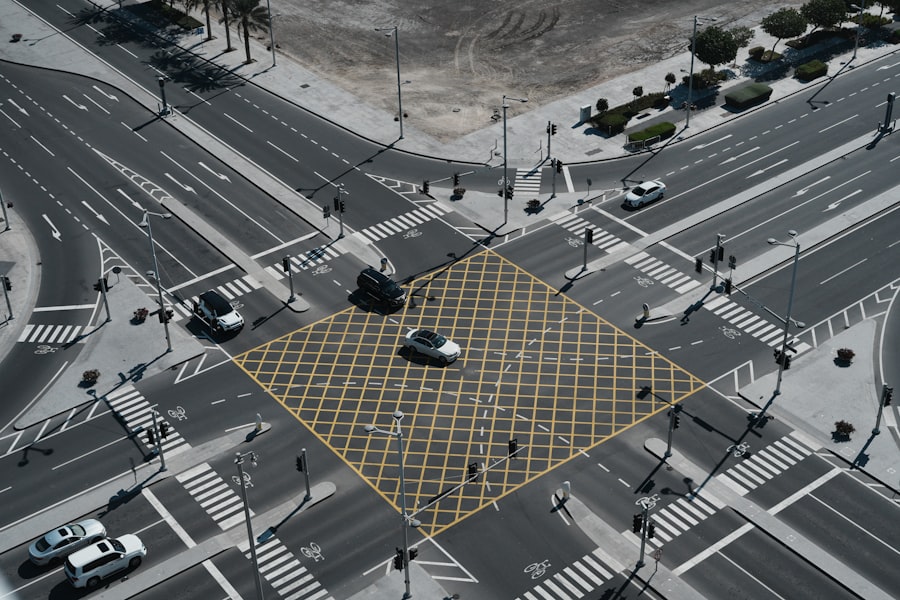The advent of smart technology has permeated various aspects of daily life, and transportation is no exception. Sensor-embedded roads represent a significant leap forward in the quest for smarter urban mobility solutions. These innovative infrastructures integrate advanced sensor technologies directly into the roadways, enabling real-time data collection and communication between vehicles, infrastructure, and traffic management systems.
The concept is rooted in the broader framework of the Internet of Things (IoT), where everyday objects are interconnected, allowing for enhanced monitoring and control. As urban populations swell and traffic congestion becomes an increasingly pressing issue, the need for intelligent traffic management systems has never been more critical. Sensor-embedded roads are designed to address the complexities of modern transportation networks.
By embedding sensors within the pavement or alongside roadways, cities can gather a wealth of information about traffic patterns, vehicle speeds, and environmental conditions. This data can be utilized to optimize traffic flow, reduce congestion, and improve safety for all road users. The integration of such technology not only enhances the efficiency of transportation systems but also contributes to sustainability efforts by minimizing emissions and energy consumption.
As cities around the globe grapple with the challenges posed by urbanization, sensor-embedded roads offer a promising solution that aligns with the goals of smart city initiatives.
Key Takeaways
- Sensor-embedded roads are revolutionizing urban mobility by enabling smart traffic flow and reducing congestion.
- Smart traffic flow benefits include improved safety, reduced travel time, lower emissions, and enhanced driver experience.
- Sensor-embedded roads work by using various technologies such as cameras, radar, and LiDAR to collect real-time data on traffic conditions.
- Data plays a crucial role in smart traffic flow by enabling predictive analytics, adaptive signal control, and dynamic routing.
- Challenges and limitations of sensor-embedded roads include cost, privacy concerns, maintenance, and potential technical issues.
The Benefits of Smart Traffic Flow
One of the most significant advantages of smart traffic flow facilitated by sensor-embedded roads is the potential for reduced congestion. Traditional traffic management systems often rely on fixed traffic signals and manual monitoring, which can lead to inefficiencies and delays. In contrast, sensor-embedded roads provide real-time data that can be used to adjust traffic signals dynamically based on current conditions.
For instance, if sensors detect a sudden influx of vehicles at a particular intersection, the traffic lights can be programmed to extend green light durations, allowing for smoother passage and reducing wait times. This adaptability not only enhances the driving experience but also decreases the likelihood of accidents caused by frustrated drivers. Moreover, smart traffic flow contributes to improved safety on the roads.
By continuously monitoring vehicle speeds and traffic density, sensor-embedded systems can identify hazardous conditions and alert drivers or traffic management centers in real time.
This proactive approach to traffic management not only minimizes the risk of collisions but also aids emergency responders in reaching incidents more swiftly.
How Sensor-Embedded Roads Work

The functionality of sensor-embedded roads hinges on a combination of various technologies that work in concert to gather and analyze data. At the core of these systems are sensors that can detect a range of parameters, including vehicle count, speed, and even environmental factors such as temperature and weather conditions. These sensors can be inductive loops embedded in the pavement, radar devices mounted on poles, or even cameras equipped with advanced image recognition software.
Each type of sensor has its strengths and weaknesses, but collectively they provide a comprehensive view of roadway conditions. Once data is collected by these sensors, it is transmitted to a central processing unit where it is analyzed in real time. This processing unit can be part of a larger traffic management system that integrates data from multiple sources, including other roads, public transportation systems, and even pedestrian movements.
The analyzed data is then used to inform decision-making processes regarding traffic signal timing, lane usage, and incident management. For instance, if a sensor detects that a particular lane is consistently underutilized during peak hours, traffic management systems can adjust signage or signal patterns to encourage its use, thereby optimizing overall traffic flow.
The Role of Data in Smart Traffic Flow
Data serves as the backbone of smart traffic flow systems enabled by sensor-embedded roads.
For example, historical data on traffic patterns can help city planners identify trends over time, such as peak travel times or recurring congestion points.
This information is invaluable for long-term infrastructure planning and investment decisions. By understanding how traffic behaves under different conditions, cities can make informed choices about where to allocate resources for road improvements or expansions. Furthermore, real-time data plays a crucial role in enhancing the responsiveness of traffic management systems.
With continuous updates from sensors, cities can implement adaptive traffic control strategies that respond instantaneously to changing conditions. For instance, during special events or emergencies, data from sensor-embedded roads can be used to create temporary detours or adjust signal timings to accommodate increased traffic volumes. This level of responsiveness not only improves efficiency but also enhances public trust in transportation systems as they become more reliable and user-friendly.
Challenges and Limitations of Sensor-Embedded Roads
Despite their numerous advantages, sensor-embedded roads are not without challenges and limitations. One significant hurdle is the initial cost associated with installing and maintaining these advanced systems. The integration of sensors into existing roadways requires substantial investment in both technology and infrastructure upgrades.
Cities with limited budgets may find it difficult to justify these expenditures, especially when competing priorities exist within urban planning agendas. Additionally, ongoing maintenance is essential to ensure that sensors remain functional and accurate over time; neglecting this aspect can lead to degraded performance and unreliable data. Another challenge lies in data privacy and security concerns.
As sensor-embedded roads collect vast amounts of information about vehicle movements and behaviors, there is an inherent risk associated with data breaches or misuse. Ensuring that sensitive information is protected while still allowing for effective data sharing among stakeholders is a complex issue that requires careful consideration. Policymakers must navigate the delicate balance between leveraging data for public benefit and safeguarding individual privacy rights.
Case Studies of Successful Smart Traffic Flow Implementation

Several cities around the world have successfully implemented sensor-embedded road technologies to enhance smart traffic flow. One notable example is Los Angeles, California, which has integrated advanced traffic management systems across its extensive network of roadways. By utilizing real-time data from embedded sensors and cameras, Los Angeles has been able to optimize signal timings dynamically based on current traffic conditions.
This initiative has led to significant reductions in travel times during peak hours and has improved overall road safety. Another compelling case study comes from Singapore, where the government has invested heavily in smart transportation technologies as part of its Smart Nation initiative. The city-state has deployed an extensive network of sensors throughout its roadways to monitor traffic flow continuously.
This data is used not only for immediate traffic management but also for long-term urban planning efforts. By analyzing trends in vehicle usage and congestion patterns, Singapore has been able to implement targeted measures such as congestion pricing and dedicated bus lanes that further enhance mobility across the city.
Future Developments and Innovations in Smart Traffic Flow Technology
The future of smart traffic flow technology is poised for exciting developments as advancements in artificial intelligence (AI), machine learning, and connectivity continue to evolve. One promising area is the integration of autonomous vehicles into sensor-embedded road systems. As self-driving cars become more prevalent, their ability to communicate with road infrastructure will enhance overall traffic management capabilities.
For instance, autonomous vehicles could receive real-time updates about road conditions or upcoming obstacles directly from embedded sensors, allowing them to adjust their routes proactively. Moreover, advancements in data analytics will enable cities to harness predictive modeling techniques that anticipate traffic patterns before they occur. By leveraging historical data alongside real-time inputs from sensors, cities could develop algorithms that predict congestion hotspots or potential accidents based on current trends.
This proactive approach would allow for preemptive measures to be taken—such as adjusting signal timings or deploying additional resources—ultimately leading to smoother traffic flow and enhanced safety.
The Impact of Sensor-Embedded Roads on Urban Mobility
The integration of sensor-embedded roads into urban transportation networks represents a transformative shift towards smarter mobility solutions. By leveraging real-time data collection and analysis capabilities, cities can optimize traffic flow, enhance safety measures, and improve overall efficiency within their transportation systems. While challenges remain regarding costs and data privacy concerns, successful case studies demonstrate the potential benefits that these technologies can bring to urban environments.
As cities continue to evolve in response to growing populations and increasing demands on infrastructure, sensor-embedded roads will play a pivotal role in shaping the future of urban mobility. With ongoing innovations on the horizon—such as AI-driven analytics and autonomous vehicle integration—the possibilities for enhancing transportation efficiency are vast. Ultimately, sensor-embedded roads stand at the forefront of creating more sustainable, efficient, and user-friendly urban transportation systems that cater to the needs of all citizens.
In the realm of technological advancements, the integration of sensor-embedded roads is revolutionizing traffic management by enabling smart traffic flow. This innovation is part of a broader trend of embedding technology into everyday infrastructure to enhance efficiency and connectivity. A related development can be seen in the workplace, where smartwatches are making a significant impact. These devices are not only transforming personal health monitoring but are also revolutionizing how tasks are managed and executed in professional settings. For more insights into this trend, you can read the article on how smartwatches are revolutionizing the workplace by visiting this link.
FAQs
What are sensor-embedded roads?
Sensor-embedded roads are roads that have been equipped with various sensors to collect data on traffic flow, vehicle speed, and road conditions. These sensors can be embedded in the pavement or installed along the roadside.
How do sensor-embedded roads work?
Sensor-embedded roads work by collecting data from the sensors and transmitting it to a central system. This data is then analyzed to provide real-time information on traffic flow, congestion, and road conditions. This information can be used to optimize traffic signal timing, improve road maintenance, and enhance overall traffic management.
What are the benefits of sensor-embedded roads?
Sensor-embedded roads can help improve traffic flow, reduce congestion, and enhance road safety. By providing real-time data on traffic conditions, these roads can also help drivers make informed decisions about their routes, leading to more efficient travel.
How are sensor-embedded roads powering smart traffic flow?
Sensor-embedded roads are powering smart traffic flow by providing real-time data that can be used to optimize traffic signal timing, manage congestion, and improve overall traffic management. This data can also be used to support the development of smart transportation systems and autonomous vehicles.

